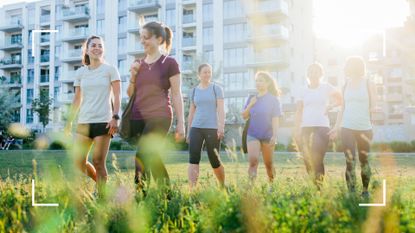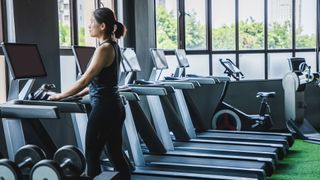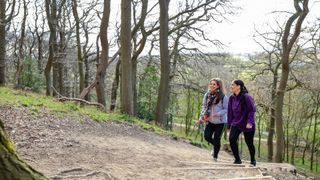Does walking build muscle? Plus, how to include the cardio exercise in your strength training
It's a great low-impact workout but does walking build muscle? Here's what a personal trainer wants you to know


It's an amazing source of cardio exercise, but does walking build muscle? Traditionally, hitting the gym is seen as the essential muscle-building component in toning up, but actually, plenty of research suggests otherwise.
The main muscles used in walking are the quadriceps, hamstrings, glutes, and lower leg muscles - including the calves. This means that walking can be a great lower-body workout, but because we use these muscles a lot in daily life, they’re probably some of our strongest already. We need a lot more resistance against them to change their size or definition.
But it’s certainly possible. So whether you’re looking for new walking workouts or want to know what you’re getting into before investing in the best walking shoes, we’ve consulted a personal trainer to offer everything there is to know about walking and building muscle.
Does walking build muscle?
Not only is it a great endurance exercise, but walking will also help tone your leg muscles, says level 4 personal trainer Luke Hughes. “Taking up walking as a daily activity can build muscle strength in some people, but mainly it will help you tone your body and increase your endurance,” he explains.
Research from the University of New Mexico shows that muscle fibers are damaged during exercise and after the workout, so the body repairs or replaces these fibers. The muscle fibers fuse together to form new strands, which is how we physically build muscle. So the more intense the exercise, the better for muscle building. This is why strength training is often more effective and beneficial than walking for larger muscle growth.
However, it’s still entirely possible to build muscle and strength through walking - especially on an incline, as you might do in Nordic walking.
Your legs aren’t the only place where walking can help build muscle either, says Hughes, who is also the CEO and co-founder of OriGym. “Although your legs may be where you feel the most tension, walking can also engage your abs, helping to stabilize your body through a great ab workout.”
Sign up for the woman&home newsletter
Sign up to our free daily email for the latest royal and entertainment news, interesting opinion, expert advice on styling and beauty trends, and no-nonsense guides to the health and wellness questions you want answered.

How to build muscle when walking
1. Focus on building an incline
If muscle building (enlarging the muscle) rather than toning (engaging in exercises that result in more defined muscle) is your goal, then you’ll need to adjust the intensity and resistance of your walk by trying something like the 12-3-30 workout. As the name suggests, you walk on the treadmill at an incline of 12 and at a pace of 3mph for 30 minutes.
“Walking on an incline is much more likely to help you build muscle as it gives your legs a challenge and activates your quads, hamstring, calves, and glutes. When walking on an incline, the calories burned is significantly greater than the average expectancy for walking on a flat surface as well,” Hughes says. So, if you’re walking for weight loss, this is definitely something to focus on.
2. Walk with weights
It’s undeniable that resistance training, like learning how to start weightlifting, is a more efficient and effective workout for muscle building than walking - plenty of research, including studies by Quincy College, says so. However, it’s not for everyone, and as the most important workout is the one you enjoy the most, it’s worth exploring how to incorporate some resistance training into your workout routine.
Exploring the benefits of ankle weights or hand weights can be one great way to do this. As long as your posture is right and you’re not dealing with any injuries, they can offer additional pressure on your legs, forcing them to work harder and your muscles to overcome the resistance.
3. Incorporate some interval training into your walking
Interval training involves rounds of exercise done at different paces and, similarly to strength training, it can be hugely beneficial for muscle building. If you're wondering 'is walking good exercise for me?', this is the place to start.
For example, begin your walking workout at an incline of 2 and a speed of 3mph on a treadmill, increasing the speed or incline every 5 minutes, until you feel like you're pushing yourself. If you do this six times, you'll be working out for just 30 minutes.
High-intensity interval training (HIIT) is also one of the best kinds of exercise if you’ve only got limited time on your hands. While walking is technically considered low-intensity steady-state cardio (LISS cardio, for short), amping up the pace or resistance can force your muscles to work a lot harder in a shower pace of time, making your workout hugely efficient.

4. Make sure you do your research if you're walking outside
Essentially, you need to make sure that your walking workout is going to work for you. This means testing out the trails and paths in the local area and being aware of the conditions they offer. One app we’d really recommend for this is AllTrails - there are over 300,000 routes to choose from worldwide and each one has a breakdown of the elevation gain within map view, so you can explore new places with ease.
“I’d strongly recommend doing prior research into the gradients and terrain of the area you intend to walk,” says Hughes. “While you may believe walking to be an easy task, do not underestimate the challenge presented before you and jump into a high gradient.”
5. Don't go too hard too soon
Although walking is a great way to incorporate the activity into your lifestyle, it doesn’t need to be an all-or-nothing approach, says the trainer. “Walking 30 minutes a day, 5 days a week is a low-impact way to work out. Walking to get fit doesn’t mean you have to cover a mile a day nor does it mean you need to complete high-intensity power walking sessions through the park.”
Tips for building muscle when walking
- Walk on uneven terrain: “It’s worth noting that when walking on a flat surface like a treadmill, you only use 20% of your leg’s muscle tissue,” says Hughes. “One of the benefits of walking on uneven terrain is that it engages far more muscle groups throughout the lower body.”
- Workout both on the treadmill and outside: “Some days you can head to your local gym and walk on a treadmill, whereas other days you may be more suited to walking in the great outdoors. It’s also a good idea to walk in different places so you can see and experience new scenery."
- Wear a weighted running vest: If ankle weights aren’t for you, you can also buy a weighted running vest that sits over your shoulders and provides additional resistance. They are more expensive but will offer a larger weight than many hand or ankle weights will.
- Make sure you've got the right shoes: A pair of the best hiking boots is a real essential if you plan on making serious progress as they’ll help you grip onto uneven or slippery terrains and stabilize your legs, reducing the chance of injury.
- Remember the health benefits of walking: Once you’ve started to build muscle walking, you may be tempted to start running. However, it’s important to note that walking is significantly less stressful on the body than running - so upping the intensity won’t be for everyone.
- Switch up your routine: Even if you’re only walking a couple of times a week, you will lack the motivation to move sometimes. Try walking meditation or a slower walk for a change of pace. “This may mean you need to switch up your routine. If you’re someone who usually prefers to walk solo, then why not bring along a friend? There’s nothing better than a partnership where you support and remind each other of your achievements," says Hughes.

Grace Walsh is woman&home's Health Channel Editor, working across the areas of fitness, nutrition, sleep, mental health, relationships, and sex. She is also a qualified fitness instructor. In 2024, she will be taking on her second marathon in Rome, cycling from Manchester to London (350km) for charity, and qualifying as a certified personal trainer and nutrition coach.
A digital journalist with over six years experience as a writer and editor for UK publications, Grace has covered (almost) everything in the world of health and wellbeing with bylines in Cosmopolitan, Red, The i Paper, GoodtoKnow, and more.
-
 Coros Pace 3 review: I almost gave this smartwatch 5-stars - but one thing stopped me
Coros Pace 3 review: I almost gave this smartwatch 5-stars - but one thing stopped meThe Coros Pace 3 is packed with useful features for runners both new and experienced, as well as detailed sleep and stress insights. It's my new favourite
By Grace Walsh Published
-
 Zara Tindall elevates monochrome black outfit with dreamiest suede trench coat and pop of leopard print
Zara Tindall elevates monochrome black outfit with dreamiest suede trench coat and pop of leopard printZara Tindall's suede coat is a flattering winter staple we'll be wearing all season long
By Charlie Elizabeth Culverhouse Published